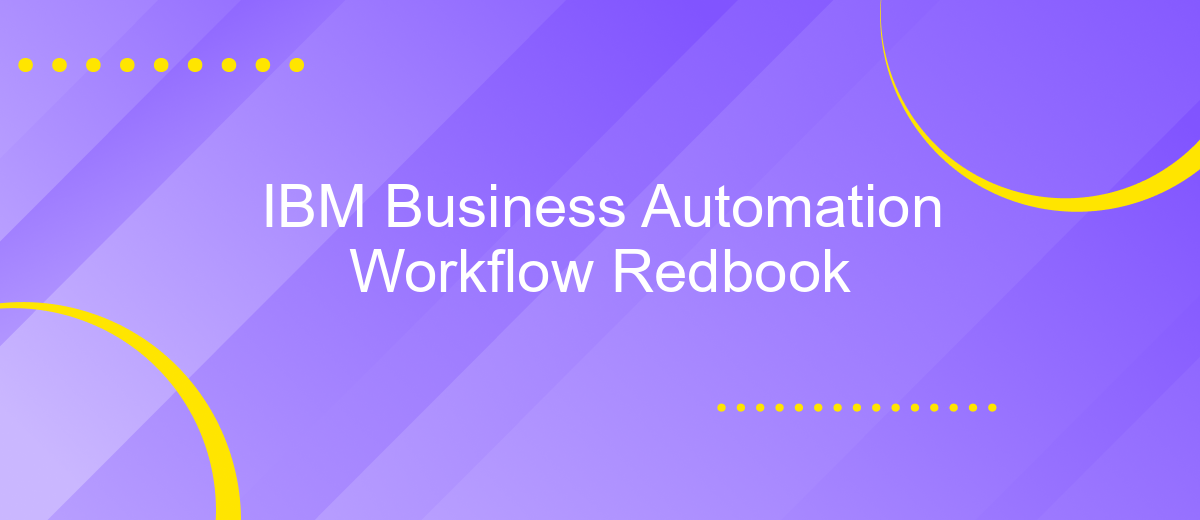IBM Business Automation Workflow Redbook
IBM Business Automation Workflow (BAW) is a comprehensive platform designed to streamline and optimize business processes through automation. This Redbook provides an in-depth look at BAW's features, capabilities, and best practices. Whether you're just starting with business automation or looking to enhance your existing workflows, this guide offers valuable insights to help you achieve operational excellence and drive business success.
Introduction
IBM Business Automation Workflow (BAW) is a comprehensive solution designed to streamline and automate business processes. It combines business process management and case management capabilities into a unified platform, enabling organizations to improve efficiency, enhance decision-making, and reduce operational costs. By leveraging IBM BAW, businesses can achieve greater agility and adaptability in their workflows.
- Unified platform for BPM and case management
- Enhanced decision-making capabilities
- Improved operational efficiency and reduced costs
- Greater agility and adaptability
One of the key advantages of IBM BAW is its ability to integrate seamlessly with various third-party services, such as ApiX-Drive. ApiX-Drive facilitates smooth integration between disparate systems, allowing for automated data transfer and synchronization. This integration capability ensures that businesses can maintain cohesive workflows across different platforms, further enhancing their operational efficiency and effectiveness.
Getting started

To get started with IBM Business Automation Workflow, you first need to ensure that your environment meets the necessary prerequisites. This includes having a compatible operating system, sufficient memory, and the required software components such as WebSphere Application Server and DB2 or an equivalent database. Once your environment is ready, you can proceed with the installation and configuration of IBM Business Automation Workflow. Detailed installation guides are available to assist you in this process, ensuring that you can set up the platform effectively and efficiently.
After the initial setup, it's crucial to integrate IBM Business Automation Workflow with other systems to streamline your business processes. One of the tools that can facilitate these integrations is ApiX-Drive. This service allows you to connect various applications and automate data transfer between them, reducing manual effort and increasing efficiency. By leveraging ApiX-Drive, you can ensure seamless communication between IBM Business Automation Workflow and your existing software ecosystem, enabling a more cohesive and automated workflow environment.
Development and testing

Development and testing in IBM Business Automation Workflow (BAW) require a systematic approach to ensure robust and efficient workflows. Developers start by designing workflows using the BAW Designer, which provides a comprehensive set of tools for modeling business processes. These workflows are then validated to ensure they meet business requirements and are free of logical errors.
- Design and model workflows using IBM BAW Designer.
- Validate workflows for logical consistency and business requirements.
- Deploy workflows in a controlled environment for initial testing.
- Use ApiX-Drive to integrate various services and automate data flow between them.
- Conduct unit and integration tests to identify and fix issues.
- Perform user acceptance testing (UAT) to ensure the solution meets end-user needs.
- Finalize deployment and monitor workflows in the production environment.
Utilizing tools like ApiX-Drive can significantly streamline the integration process, allowing seamless data transfer between different services and systems. This enhances the overall efficiency of the development and testing phases, ensuring that the final product is both reliable and effective. Continuous monitoring and iterative testing are crucial to maintaining the integrity and performance of the deployed workflows.
Deployment

Deploying IBM Business Automation Workflow (BAW) involves several critical steps to ensure a smooth and efficient implementation. The process begins with preparing your environment, including hardware and software prerequisites. Proper planning and resource allocation are essential to avoid potential pitfalls during deployment.
Next, you need to install and configure the IBM BAW software. This step involves setting up databases, application servers, and other necessary components. It's crucial to follow IBM's guidelines and best practices to ensure a successful installation. Additionally, consider leveraging integration services like ApiX-Drive to streamline the connection between IBM BAW and other business applications.
- Prepare environment: Check hardware and software prerequisites.
- Install IBM BAW: Follow IBM's installation guidelines.
- Configure components: Set up databases, application servers, etc.
- Integrate with other systems: Use services like ApiX-Drive for seamless integration.
After completing the installation and initial configuration, it's essential to test the deployment thoroughly. Ensure all components are functioning correctly and that the system meets business requirements. Regular monitoring and maintenance will help keep the IBM BAW environment running smoothly, allowing your organization to fully leverage its capabilities.
- Automate the work of an online store or landing
- Empower through integration
- Don't spend money on programmers and integrators
- Save time by automating routine tasks
Performance and scalability
IBM Business Automation Workflow is designed to deliver high performance and scalability, ensuring that enterprises can efficiently manage complex workflows and business processes. To achieve optimal performance, it is crucial to fine-tune system configurations, monitor resource utilization, and implement best practices for database management. Regularly updating hardware and software components also plays a significant role in maintaining system efficiency and responsiveness.
Scalability is another critical aspect, as it allows businesses to handle increasing workloads without compromising performance. IBM Business Automation Workflow supports horizontal and vertical scaling to accommodate growing demands. Integrating with services like ApiX-Drive can further enhance scalability by streamlining data synchronization and automating tasks across various platforms. By leveraging these integrations, organizations can achieve seamless operations and ensure that their workflow automation remains robust and adaptable to future needs.
FAQ
What is IBM Business Automation Workflow?
How does IBM BAW integrate with other enterprise systems?
What are the key features of IBM Business Automation Workflow?
How can I get started with automating workflows using IBM BAW?
What are the benefits of using IBM Business Automation Workflow?
Time is the most valuable resource for business today. Almost half of it is wasted on routine tasks. Your employees are constantly forced to perform monotonous tasks that are difficult to classify as important and specialized. You can leave everything as it is by hiring additional employees, or you can automate most of the business processes using the ApiX-Drive online connector to get rid of unnecessary time and money expenses once and for all. The choice is yours!


